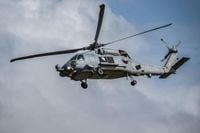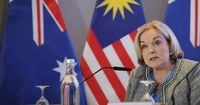New Zealand has unveiled a sweeping defense modernization plan, committing nearly NZ$3 billion (US$1.6 billion) to overhaul its aging military aircraft fleet in a move that signals a major shift in the nation’s strategic priorities. The announcement, made in Wellington on August 21, 2025, by Defense Minister Judith Collins and Foreign Minister Winston Peters, comes as global tensions rise and the security environment in the Pacific region grows more complex.
The centerpiece of the package is the acquisition of five MH-60R Seahawk helicopters from the United States, set to replace the Royal New Zealand Navy’s aging maritime fleet. Alongside the helicopters, the government will procure two Airbus A321XLR long-range aircraft, which are slated to retire the country’s notoriously unreliable Boeing 757 jets—aircraft that have become something of a running joke in New Zealand political circles due to repeated breakdowns and travel disruptions for prime ministers and officials.
“These are once-in-a-generation investments which are a vital down payment on our future security and our prosperity in a world where tensions are rising and distance no longer provides New Zealand the protection it once did,” Collins stated at a press conference, according to The Guardian.
The scale of the commitment is unprecedented for New Zealand, a nation whose defense spending has long lagged behind its partners in the Five Eyes intelligence alliance—namely the United States, Britain, Canada, and Australia. The new plan aims to double defense spending from 1% to 2% of GDP over the next decade, as outlined in a government strategy released in April. This is part of a broader NZ$9 billion boost to defense over the next four years, reflecting a marked change in attitude toward national security for the remote island nation.
Collins emphasized that the government would “move at pace” to procure the helicopters directly through the United States’ foreign military sales program, forgoing a wider tender process. She explained that the final business case for the purchase is expected to be considered by cabinet ministers in 2026. However, she cautioned that acquiring the new helicopters could take several years, as New Zealand will have to "wait in line" for new production slots—a reality of modern military procurement.
The five MH-60R Seahawk helicopters, which account for more than NZ$2 billion of the total spending, are the same model used by Australia, the United States, and several other countries. According to AP News, the helicopters will be equipped with torpedoes and missiles, significantly enhancing the lethality and defensive capability of New Zealand’s fleet. This upgrade is also expected to ensure a more integrated Anzac force with Australia, strengthening the longstanding military partnership between the two countries.
The two Airbus A321XLR aircraft, acquired on a six-year lease-to-buy arrangement, are expected to be ready for use in 2028. Collins highlighted a key advantage: these planes are capable of returning safely from Antarctica if unable to land due to adverse conditions—a crucial feature for a country whose military often undertakes missions to the icy continent.
The need for new aircraft has become increasingly urgent. The aging Boeing 757s, which have been in service for over 30 years (and were already second-hand when purchased), have been plagued with maintenance issues. Prime Minister Christopher Luxon has previously called the situation “incredibly embarrassing,” after being forced to take a last-minute commercial flight to Australia when the official plane was grounded. Former leaders Jacinda Ardern, John Key, and Chris Hipkins have all faced similar predicaments, with backup planes sometimes required for overseas trips due to reliability concerns, as reported by The Guardian.
For many years, New Zealand’s defense posture has been shaped by its geographical isolation and a perception that distance offered a natural shield against threats. But that thinking is changing fast. “Distance no longer provides New Zealand the protection it once did,” Collins told reporters, echoing a sentiment that’s gaining traction across the political spectrum. “And defense is not something that can be mothballed until you need it.”
Foreign Minister Winston Peters, a veteran of New Zealand politics, didn’t mince words about the gravity of the moment. “We face the most challenging strategic circumstances in New Zealand’s modern history and certainly the worst that anyone today working in politics or foreign affairs can remember,” Peters said, as quoted by AP News and Euronews. He pointed to rapidly escalating global tensions and a sharply deteriorating security environment as the main drivers behind the government’s decision.
The timing of the announcement is no coincidence. Just this month, the leaders of New Zealand and neighboring Australia pledged to deepen military cooperation in response to the growing influence of China in the South Pacific. Once overlooked by Western powers, the region has become a battleground for diplomatic and strategic influence, with Beijing’s efforts to woo Pacific leaders prompting a significant reassessment in Canberra and Wellington alike.
New Zealand’s military has traditionally focused on humanitarian and disaster relief missions, with limited emphasis on combat readiness. This has made selling the need for higher defense spending a tough proposition to a public of five million people, many of whom still view their country as safely tucked away from global conflict. But as Collins put it, “We need a force that is ready and equipped to do whatever is asked of it today, tomorrow and beyond, and to ensure we can deploy, deter, defend and respond to protect New Zealand.”
Some have questioned whether the decision to buy from the United States is linked to trade considerations, especially given the 15% tariffs imposed on New Zealand goods under the Trump administration’s global tariffs plan. Collins was quick to dispel such speculation, saying she didn’t know whether the purchase would be used as leverage in trade negotiations and emphasizing that the move was driven purely by defense needs, according to Euronews.
The announcement coincided with a report from New Zealand’s spy agency, which warned of the toughest national security challenges in recent history, including rising risks of foreign interference and espionage—particularly from China. The new investments, officials say, are designed to ensure New Zealand can meet these challenges head-on and maintain both its sovereignty and economic prosperity in an increasingly uncertain world.
While it will take several years for the new helicopters and aircraft to arrive, the government’s commitment marks a decisive step toward a more robust and capable defense force. For a country long known for its peaceful image and reluctance to spend big on the military, the message is clear: New Zealand is gearing up for a new era—one where security can no longer be taken for granted.





